Analyzing Workplace Transformation: A Case Study of Unilever
VerifiedAdded on 2023/06/16
|19
|4266
|278
Case Study
AI Summary
This case study examines Unilever's workplace transformation in the digital age, focusing on talent management strategies for attracting and retaining employees. It explores the meaning of workplace transformation, analyzes strategies used by Unilever, and evaluates the challenges faced during implementation. The research methodology includes primary research through questionnaires and secondary research using journals and articles. Findings from the questionnaire responses are presented, highlighting the impact of external environmental factors, particularly social factors, on Unilever's working environment. The study concludes that effective talent management strategies and workplace transformation are crucial for navigating the competitive environment and achieving organizational objectives, despite challenges such as resistance to change and budgetary issues.
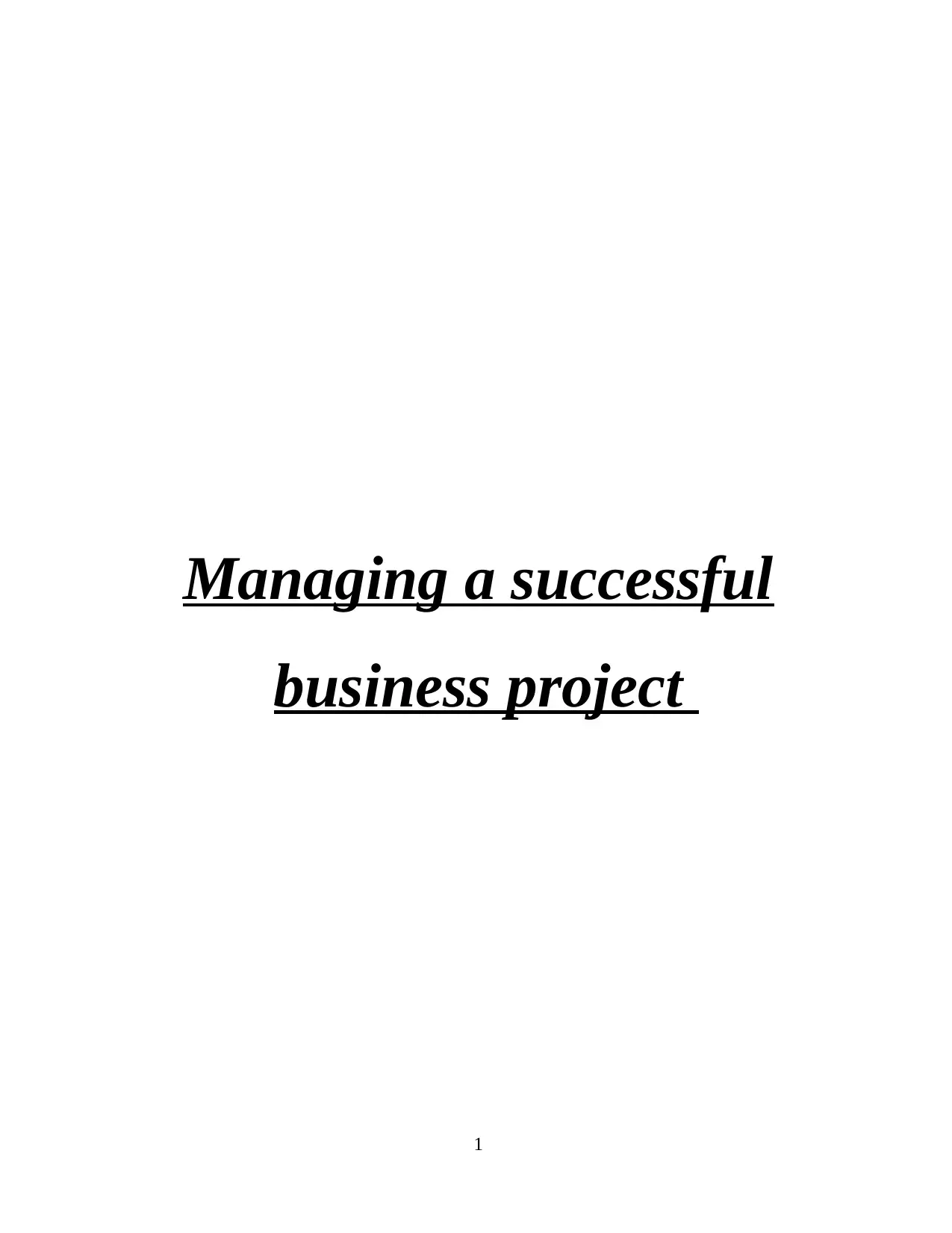
Managing a successful
business project
1
business project
1
Paraphrase This Document
Need a fresh take? Get an instant paraphrase of this document with our AI Paraphraser
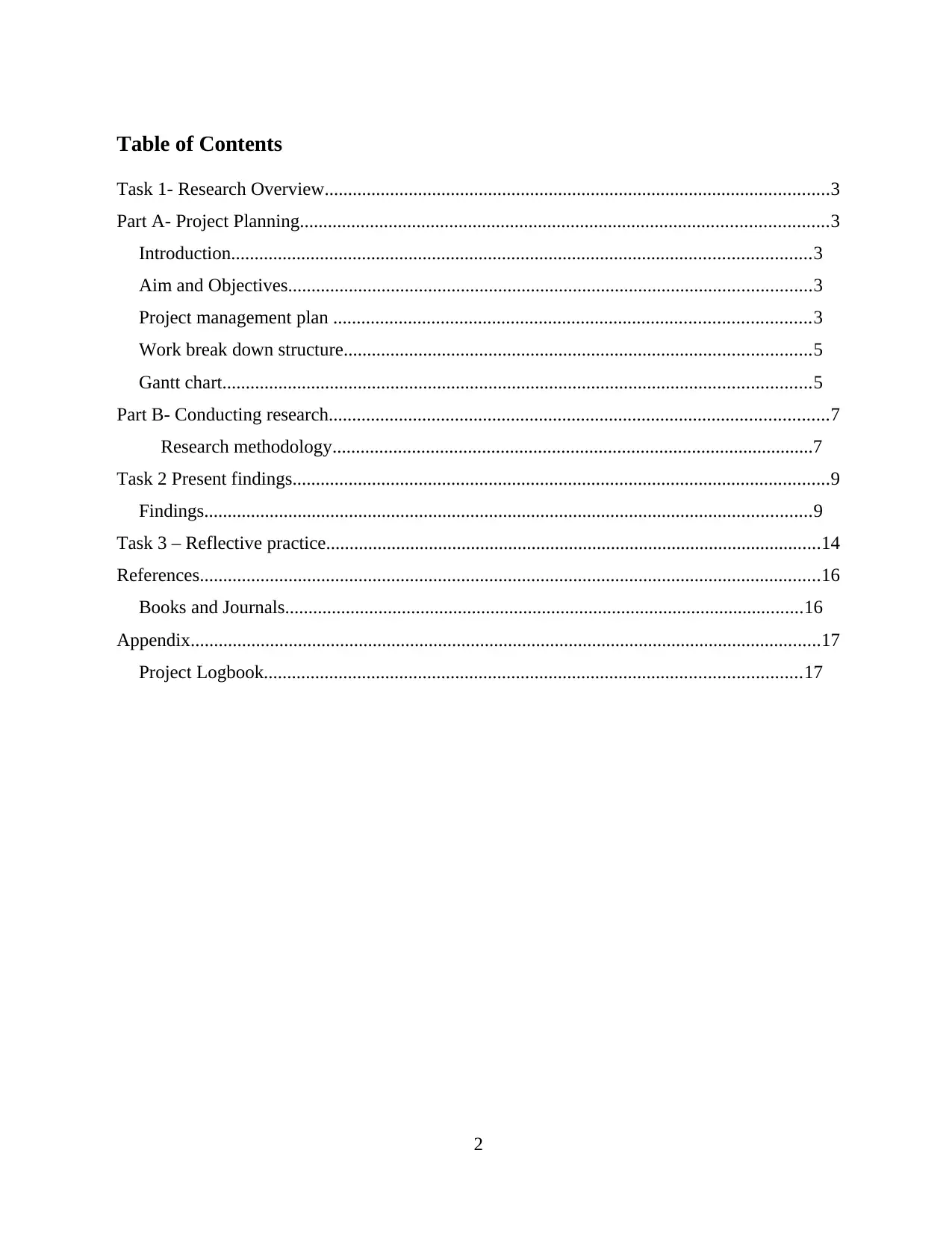
Table of Contents
Task 1- Research Overview............................................................................................................3
Part A- Project Planning.................................................................................................................3
Introduction............................................................................................................................3
Aim and Objectives................................................................................................................3
Project management plan ......................................................................................................3
Work break down structure....................................................................................................5
Gantt chart..............................................................................................................................5
Part B- Conducting research...........................................................................................................7
Research methodology.......................................................................................................7
Task 2 Present findings...................................................................................................................9
Findings..................................................................................................................................9
Task 3 – Reflective practice..........................................................................................................14
References.....................................................................................................................................16
Books and Journals...............................................................................................................16
Appendix.......................................................................................................................................17
Project Logbook...................................................................................................................17
2
Task 1- Research Overview............................................................................................................3
Part A- Project Planning.................................................................................................................3
Introduction............................................................................................................................3
Aim and Objectives................................................................................................................3
Project management plan ......................................................................................................3
Work break down structure....................................................................................................5
Gantt chart..............................................................................................................................5
Part B- Conducting research...........................................................................................................7
Research methodology.......................................................................................................7
Task 2 Present findings...................................................................................................................9
Findings..................................................................................................................................9
Task 3 – Reflective practice..........................................................................................................14
References.....................................................................................................................................16
Books and Journals...............................................................................................................16
Appendix.......................................................................................................................................17
Project Logbook...................................................................................................................17
2
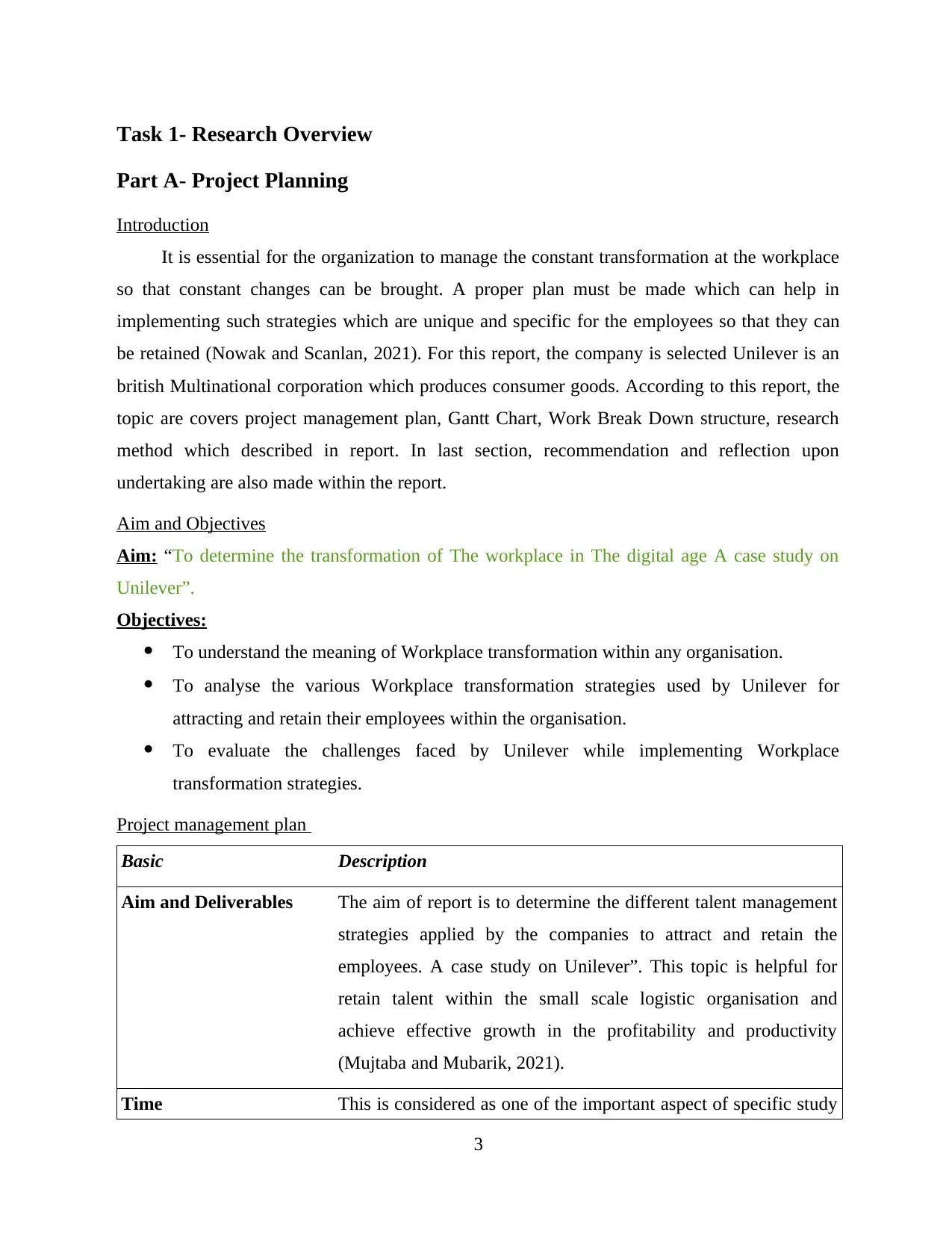
Task 1- Research Overview
Part A- Project Planning
Introduction
It is essential for the organization to manage the constant transformation at the workplace
so that constant changes can be brought. A proper plan must be made which can help in
implementing such strategies which are unique and specific for the employees so that they can
be retained (Nowak and Scanlan, 2021). For this report, the company is selected Unilever is an
british Multinational corporation which produces consumer goods. According to this report, the
topic are covers project management plan, Gantt Chart, Work Break Down structure, research
method which described in report. In last section, recommendation and reflection upon
undertaking are also made within the report.
Aim and Objectives
Aim: “To determine the transformation of The workplace in The digital age A case study on
Unilever”.
Objectives:
To understand the meaning of Workplace transformation within any organisation.
To analyse the various Workplace transformation strategies used by Unilever for
attracting and retain their employees within the organisation.
To evaluate the challenges faced by Unilever while implementing Workplace
transformation strategies.
Project management plan
Basic Description
Aim and Deliverables The aim of report is to determine the different talent management
strategies applied by the companies to attract and retain the
employees. A case study on Unilever”. This topic is helpful for
retain talent within the small scale logistic organisation and
achieve effective growth in the profitability and productivity
(Mujtaba and Mubarik, 2021).
Time This is considered as one of the important aspect of specific study
3
Part A- Project Planning
Introduction
It is essential for the organization to manage the constant transformation at the workplace
so that constant changes can be brought. A proper plan must be made which can help in
implementing such strategies which are unique and specific for the employees so that they can
be retained (Nowak and Scanlan, 2021). For this report, the company is selected Unilever is an
british Multinational corporation which produces consumer goods. According to this report, the
topic are covers project management plan, Gantt Chart, Work Break Down structure, research
method which described in report. In last section, recommendation and reflection upon
undertaking are also made within the report.
Aim and Objectives
Aim: “To determine the transformation of The workplace in The digital age A case study on
Unilever”.
Objectives:
To understand the meaning of Workplace transformation within any organisation.
To analyse the various Workplace transformation strategies used by Unilever for
attracting and retain their employees within the organisation.
To evaluate the challenges faced by Unilever while implementing Workplace
transformation strategies.
Project management plan
Basic Description
Aim and Deliverables The aim of report is to determine the different talent management
strategies applied by the companies to attract and retain the
employees. A case study on Unilever”. This topic is helpful for
retain talent within the small scale logistic organisation and
achieve effective growth in the profitability and productivity
(Mujtaba and Mubarik, 2021).
Time This is considered as one of the important aspect of specific study
3
⊘ This is a preview!⊘
Do you want full access?
Subscribe today to unlock all pages.

Trusted by 1+ million students worldwide
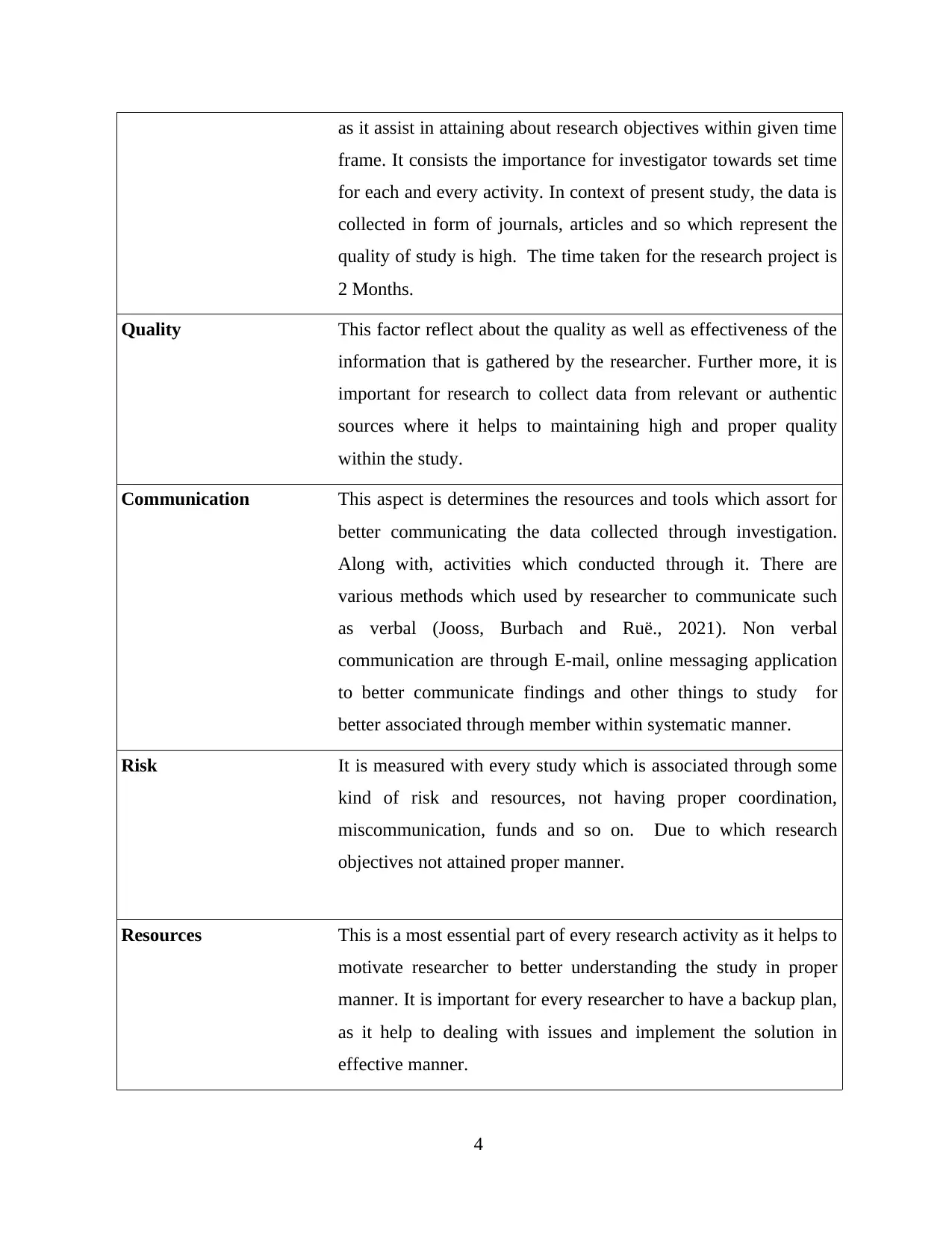
as it assist in attaining about research objectives within given time
frame. It consists the importance for investigator towards set time
for each and every activity. In context of present study, the data is
collected in form of journals, articles and so which represent the
quality of study is high. The time taken for the research project is
2 Months.
Quality This factor reflect about the quality as well as effectiveness of the
information that is gathered by the researcher. Further more, it is
important for research to collect data from relevant or authentic
sources where it helps to maintaining high and proper quality
within the study.
Communication This aspect is determines the resources and tools which assort for
better communicating the data collected through investigation.
Along with, activities which conducted through it. There are
various methods which used by researcher to communicate such
as verbal (Jooss, Burbach and Ruë., 2021). Non verbal
communication are through E-mail, online messaging application
to better communicate findings and other things to study for
better associated through member within systematic manner.
Risk It is measured with every study which is associated through some
kind of risk and resources, not having proper coordination,
miscommunication, funds and so on. Due to which research
objectives not attained proper manner.
Resources This is a most essential part of every research activity as it helps to
motivate researcher to better understanding the study in proper
manner. It is important for every researcher to have a backup plan,
as it help to dealing with issues and implement the solution in
effective manner.
4
frame. It consists the importance for investigator towards set time
for each and every activity. In context of present study, the data is
collected in form of journals, articles and so which represent the
quality of study is high. The time taken for the research project is
2 Months.
Quality This factor reflect about the quality as well as effectiveness of the
information that is gathered by the researcher. Further more, it is
important for research to collect data from relevant or authentic
sources where it helps to maintaining high and proper quality
within the study.
Communication This aspect is determines the resources and tools which assort for
better communicating the data collected through investigation.
Along with, activities which conducted through it. There are
various methods which used by researcher to communicate such
as verbal (Jooss, Burbach and Ruë., 2021). Non verbal
communication are through E-mail, online messaging application
to better communicate findings and other things to study for
better associated through member within systematic manner.
Risk It is measured with every study which is associated through some
kind of risk and resources, not having proper coordination,
miscommunication, funds and so on. Due to which research
objectives not attained proper manner.
Resources This is a most essential part of every research activity as it helps to
motivate researcher to better understanding the study in proper
manner. It is important for every researcher to have a backup plan,
as it help to dealing with issues and implement the solution in
effective manner.
4
Paraphrase This Document
Need a fresh take? Get an instant paraphrase of this document with our AI Paraphraser
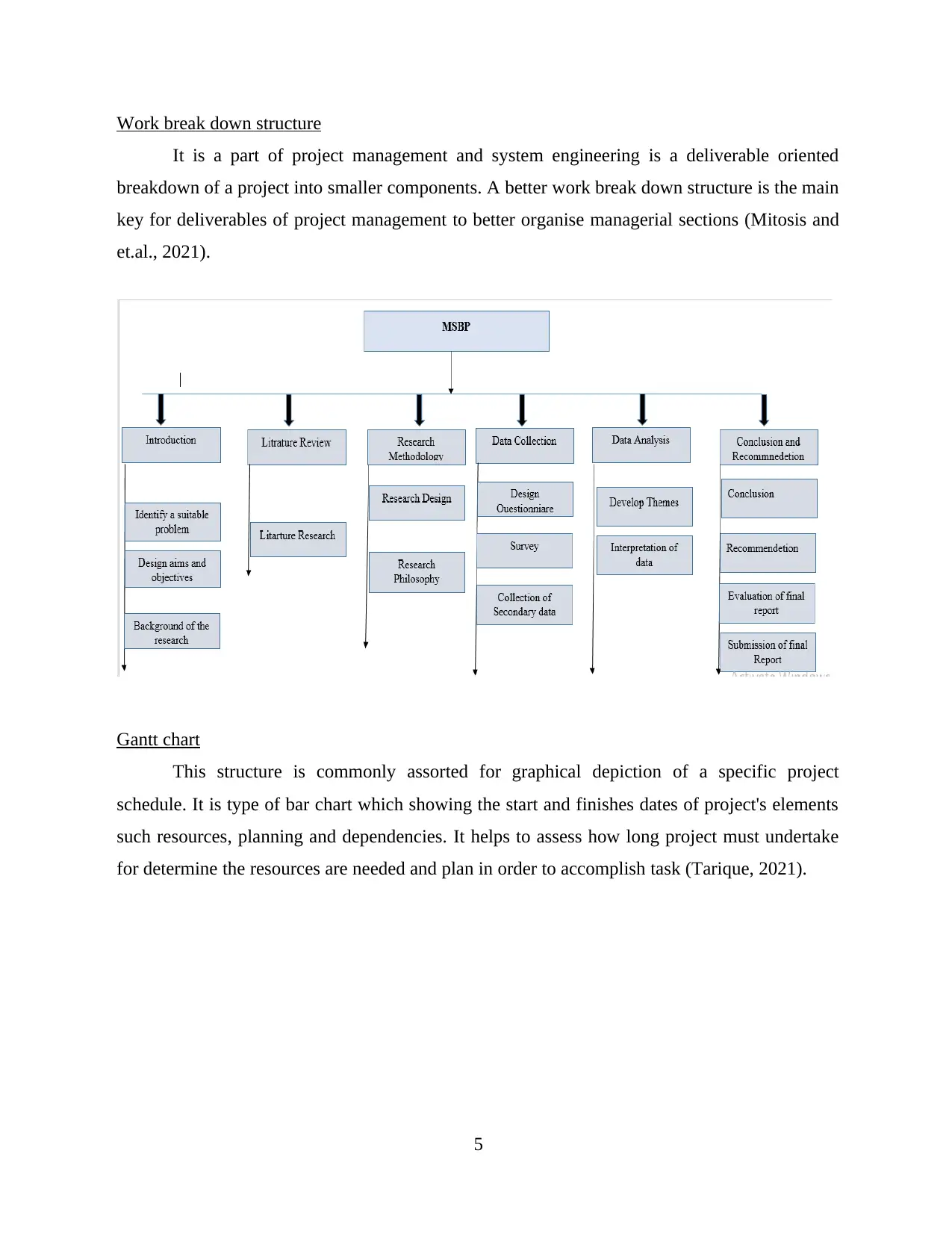
Work break down structure
It is a part of project management and system engineering is a deliverable oriented
breakdown of a project into smaller components. A better work break down structure is the main
key for deliverables of project management to better organise managerial sections (Mitosis and
et.al., 2021).
Gantt chart
This structure is commonly assorted for graphical depiction of a specific project
schedule. It is type of bar chart which showing the start and finishes dates of project's elements
such resources, planning and dependencies. It helps to assess how long project must undertake
for determine the resources are needed and plan in order to accomplish task (Tarique, 2021).
5
It is a part of project management and system engineering is a deliverable oriented
breakdown of a project into smaller components. A better work break down structure is the main
key for deliverables of project management to better organise managerial sections (Mitosis and
et.al., 2021).
Gantt chart
This structure is commonly assorted for graphical depiction of a specific project
schedule. It is type of bar chart which showing the start and finishes dates of project's elements
such resources, planning and dependencies. It helps to assess how long project must undertake
for determine the resources are needed and plan in order to accomplish task (Tarique, 2021).
5
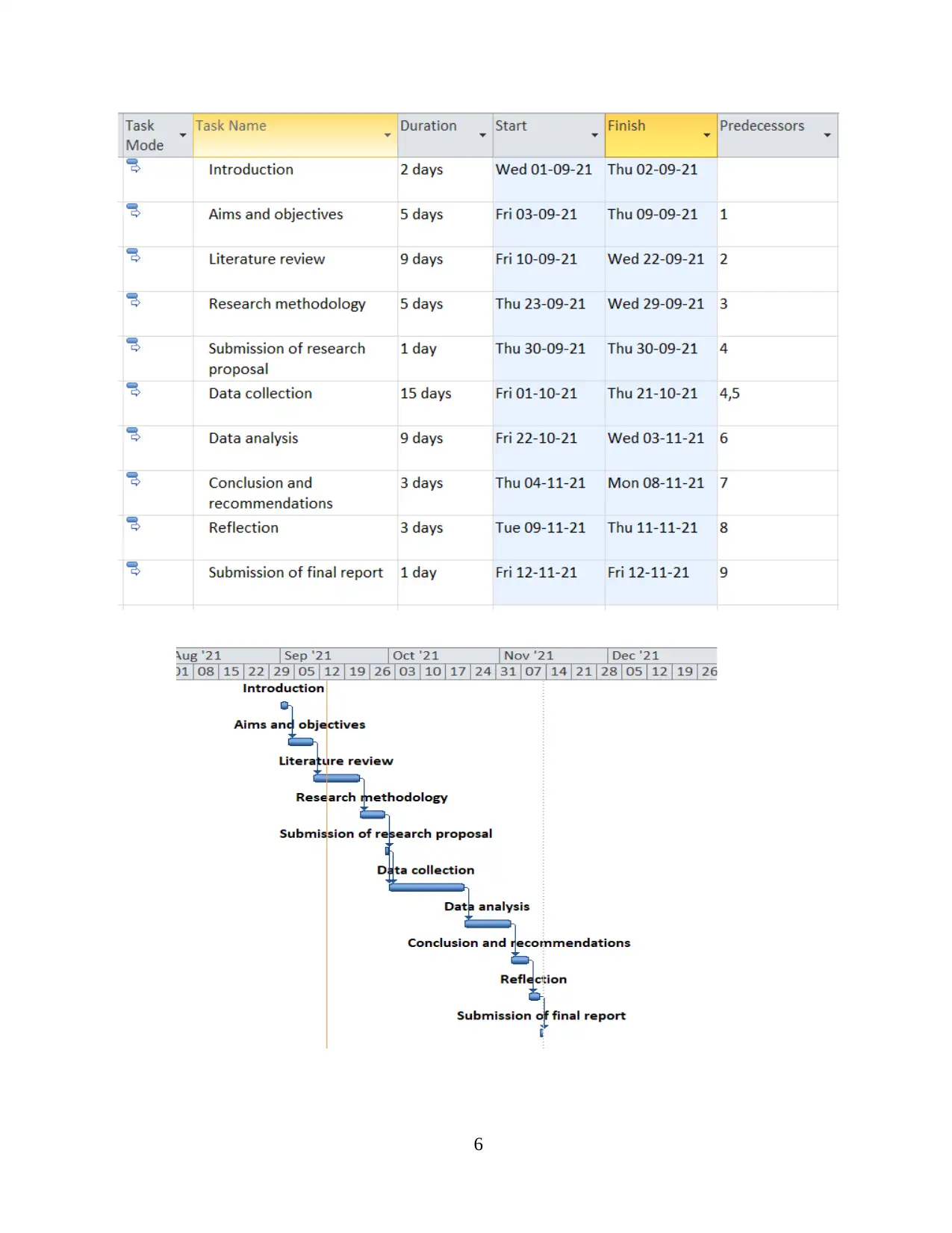
6
⊘ This is a preview!⊘
Do you want full access?
Subscribe today to unlock all pages.

Trusted by 1+ million students worldwide
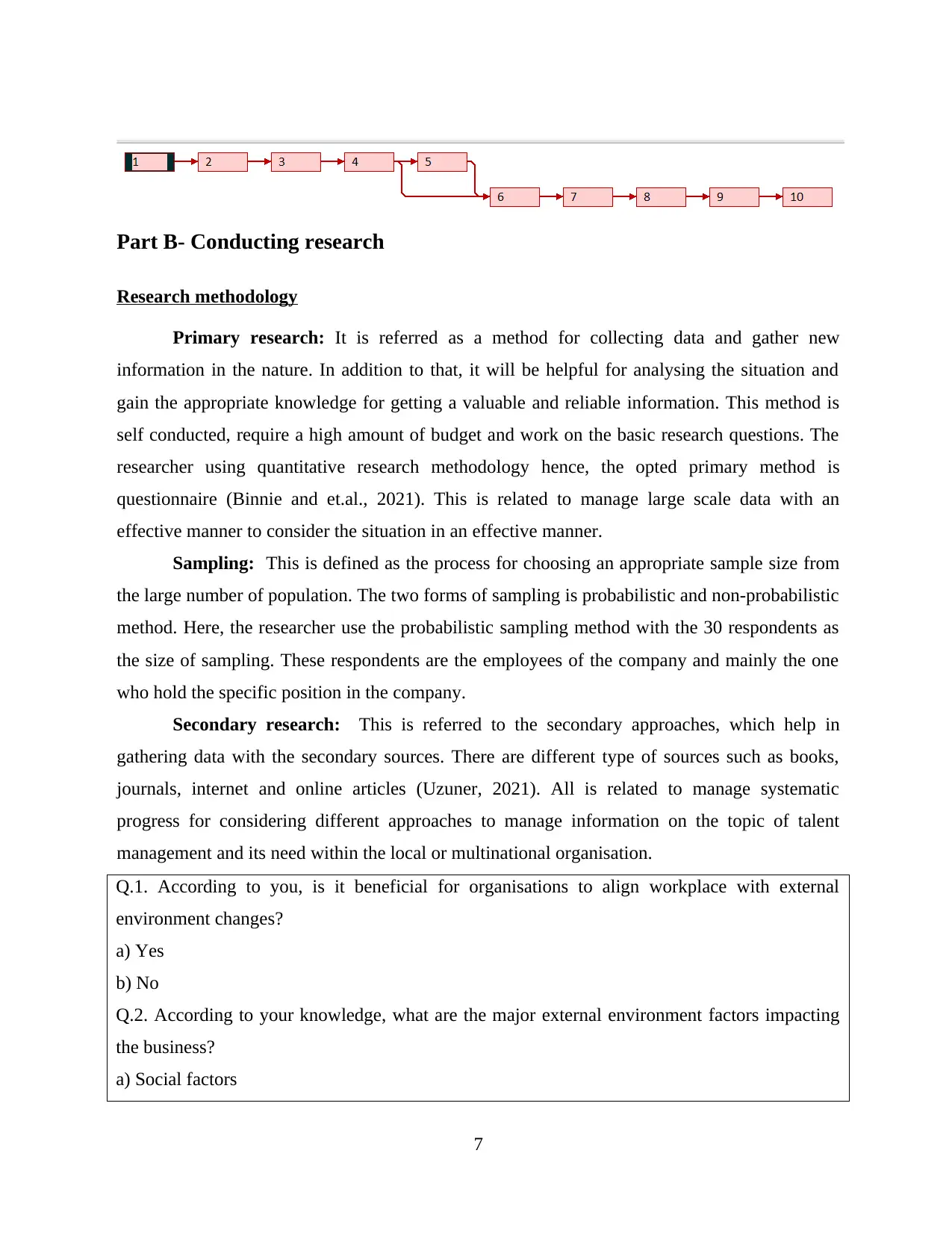
Part B- Conducting research
Research methodology
Primary research: It is referred as a method for collecting data and gather new
information in the nature. In addition to that, it will be helpful for analysing the situation and
gain the appropriate knowledge for getting a valuable and reliable information. This method is
self conducted, require a high amount of budget and work on the basic research questions. The
researcher using quantitative research methodology hence, the opted primary method is
questionnaire (Binnie and et.al., 2021). This is related to manage large scale data with an
effective manner to consider the situation in an effective manner.
Sampling: This is defined as the process for choosing an appropriate sample size from
the large number of population. The two forms of sampling is probabilistic and non-probabilistic
method. Here, the researcher use the probabilistic sampling method with the 30 respondents as
the size of sampling. These respondents are the employees of the company and mainly the one
who hold the specific position in the company.
Secondary research: This is referred to the secondary approaches, which help in
gathering data with the secondary sources. There are different type of sources such as books,
journals, internet and online articles (Uzuner, 2021). All is related to manage systematic
progress for considering different approaches to manage information on the topic of talent
management and its need within the local or multinational organisation.
Q.1. According to you, is it beneficial for organisations to align workplace with external
environment changes?
a) Yes
b) No
Q.2. According to your knowledge, what are the major external environment factors impacting
the business?
a) Social factors
7
Research methodology
Primary research: It is referred as a method for collecting data and gather new
information in the nature. In addition to that, it will be helpful for analysing the situation and
gain the appropriate knowledge for getting a valuable and reliable information. This method is
self conducted, require a high amount of budget and work on the basic research questions. The
researcher using quantitative research methodology hence, the opted primary method is
questionnaire (Binnie and et.al., 2021). This is related to manage large scale data with an
effective manner to consider the situation in an effective manner.
Sampling: This is defined as the process for choosing an appropriate sample size from
the large number of population. The two forms of sampling is probabilistic and non-probabilistic
method. Here, the researcher use the probabilistic sampling method with the 30 respondents as
the size of sampling. These respondents are the employees of the company and mainly the one
who hold the specific position in the company.
Secondary research: This is referred to the secondary approaches, which help in
gathering data with the secondary sources. There are different type of sources such as books,
journals, internet and online articles (Uzuner, 2021). All is related to manage systematic
progress for considering different approaches to manage information on the topic of talent
management and its need within the local or multinational organisation.
Q.1. According to you, is it beneficial for organisations to align workplace with external
environment changes?
a) Yes
b) No
Q.2. According to your knowledge, what are the major external environment factors impacting
the business?
a) Social factors
7
Paraphrase This Document
Need a fresh take? Get an instant paraphrase of this document with our AI Paraphraser
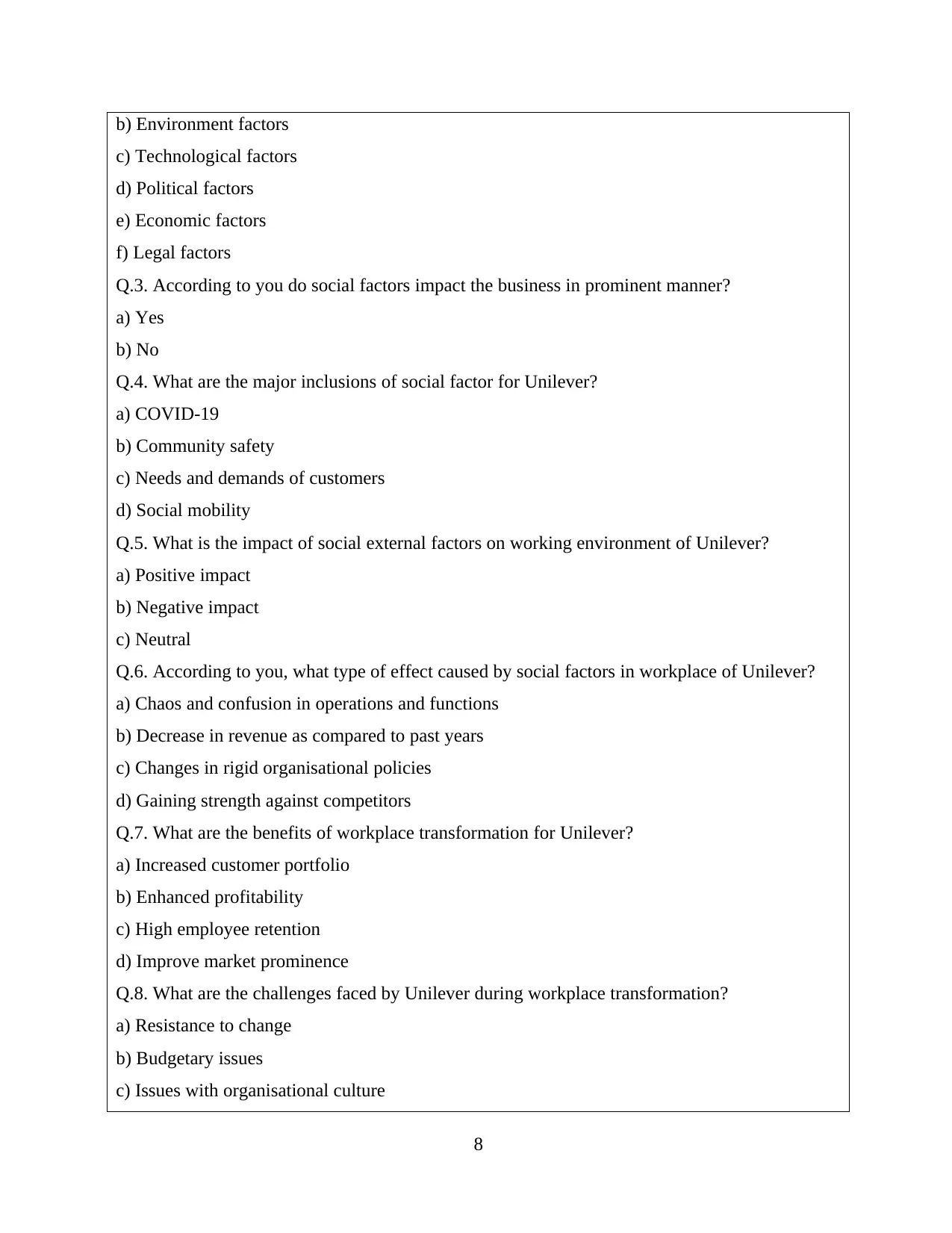
b) Environment factors
c) Technological factors
d) Political factors
e) Economic factors
f) Legal factors
Q.3. According to you do social factors impact the business in prominent manner?
a) Yes
b) No
Q.4. What are the major inclusions of social factor for Unilever?
a) COVID-19
b) Community safety
c) Needs and demands of customers
d) Social mobility
Q.5. What is the impact of social external factors on working environment of Unilever?
a) Positive impact
b) Negative impact
c) Neutral
Q.6. According to you, what type of effect caused by social factors in workplace of Unilever?
a) Chaos and confusion in operations and functions
b) Decrease in revenue as compared to past years
c) Changes in rigid organisational policies
d) Gaining strength against competitors
Q.7. What are the benefits of workplace transformation for Unilever?
a) Increased customer portfolio
b) Enhanced profitability
c) High employee retention
d) Improve market prominence
Q.8. What are the challenges faced by Unilever during workplace transformation?
a) Resistance to change
b) Budgetary issues
c) Issues with organisational culture
8
c) Technological factors
d) Political factors
e) Economic factors
f) Legal factors
Q.3. According to you do social factors impact the business in prominent manner?
a) Yes
b) No
Q.4. What are the major inclusions of social factor for Unilever?
a) COVID-19
b) Community safety
c) Needs and demands of customers
d) Social mobility
Q.5. What is the impact of social external factors on working environment of Unilever?
a) Positive impact
b) Negative impact
c) Neutral
Q.6. According to you, what type of effect caused by social factors in workplace of Unilever?
a) Chaos and confusion in operations and functions
b) Decrease in revenue as compared to past years
c) Changes in rigid organisational policies
d) Gaining strength against competitors
Q.7. What are the benefits of workplace transformation for Unilever?
a) Increased customer portfolio
b) Enhanced profitability
c) High employee retention
d) Improve market prominence
Q.8. What are the challenges faced by Unilever during workplace transformation?
a) Resistance to change
b) Budgetary issues
c) Issues with organisational culture
8
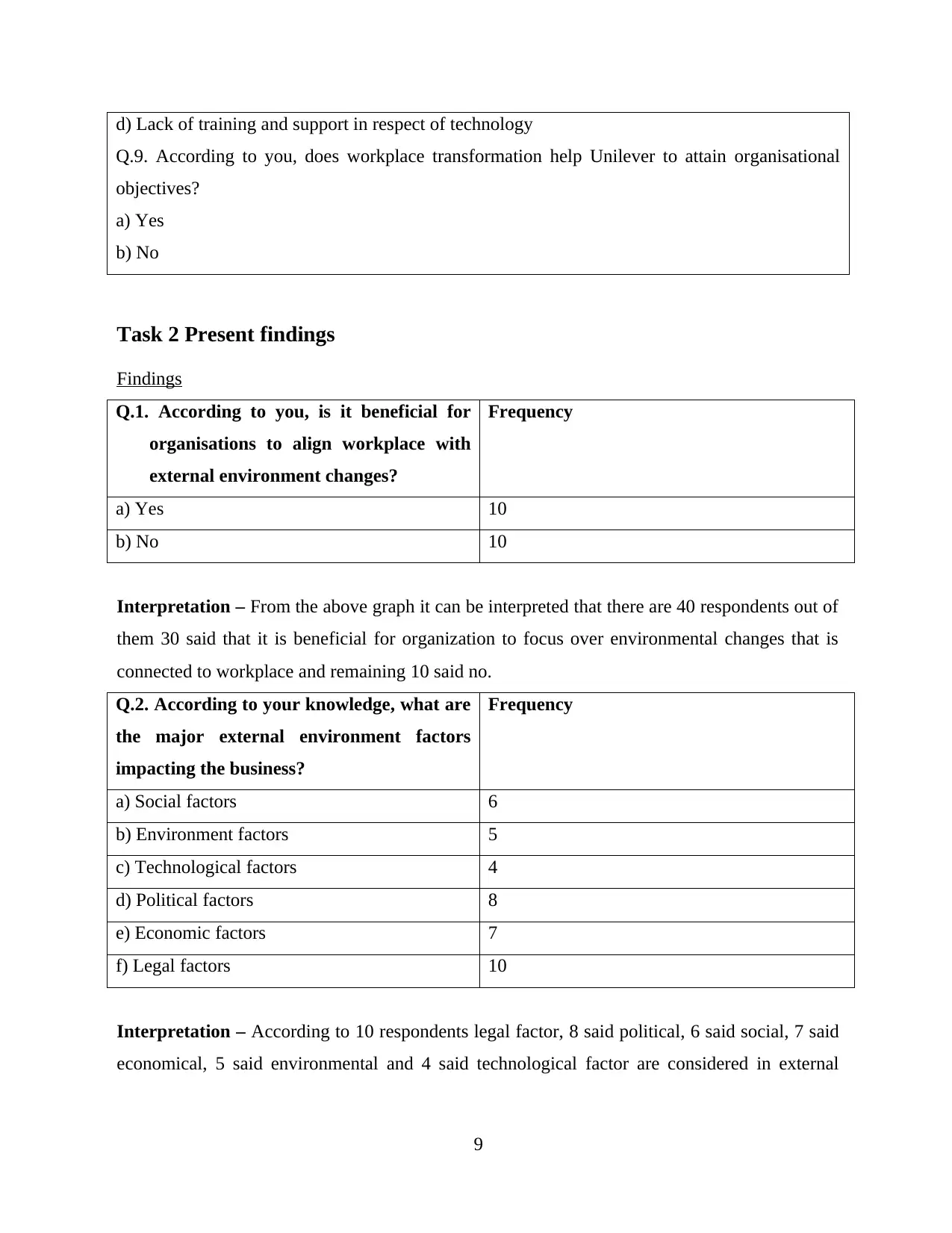
d) Lack of training and support in respect of technology
Q.9. According to you, does workplace transformation help Unilever to attain organisational
objectives?
a) Yes
b) No
Task 2 Present findings
Findings
Q.1. According to you, is it beneficial for
organisations to align workplace with
external environment changes?
Frequency
a) Yes 10
b) No 10
Interpretation – From the above graph it can be interpreted that there are 40 respondents out of
them 30 said that it is beneficial for organization to focus over environmental changes that is
connected to workplace and remaining 10 said no.
Q.2. According to your knowledge, what are
the major external environment factors
impacting the business?
Frequency
a) Social factors 6
b) Environment factors 5
c) Technological factors 4
d) Political factors 8
e) Economic factors 7
f) Legal factors 10
Interpretation – According to 10 respondents legal factor, 8 said political, 6 said social, 7 said
economical, 5 said environmental and 4 said technological factor are considered in external
9
Q.9. According to you, does workplace transformation help Unilever to attain organisational
objectives?
a) Yes
b) No
Task 2 Present findings
Findings
Q.1. According to you, is it beneficial for
organisations to align workplace with
external environment changes?
Frequency
a) Yes 10
b) No 10
Interpretation – From the above graph it can be interpreted that there are 40 respondents out of
them 30 said that it is beneficial for organization to focus over environmental changes that is
connected to workplace and remaining 10 said no.
Q.2. According to your knowledge, what are
the major external environment factors
impacting the business?
Frequency
a) Social factors 6
b) Environment factors 5
c) Technological factors 4
d) Political factors 8
e) Economic factors 7
f) Legal factors 10
Interpretation – According to 10 respondents legal factor, 8 said political, 6 said social, 7 said
economical, 5 said environmental and 4 said technological factor are considered in external
9
⊘ This is a preview!⊘
Do you want full access?
Subscribe today to unlock all pages.

Trusted by 1+ million students worldwide
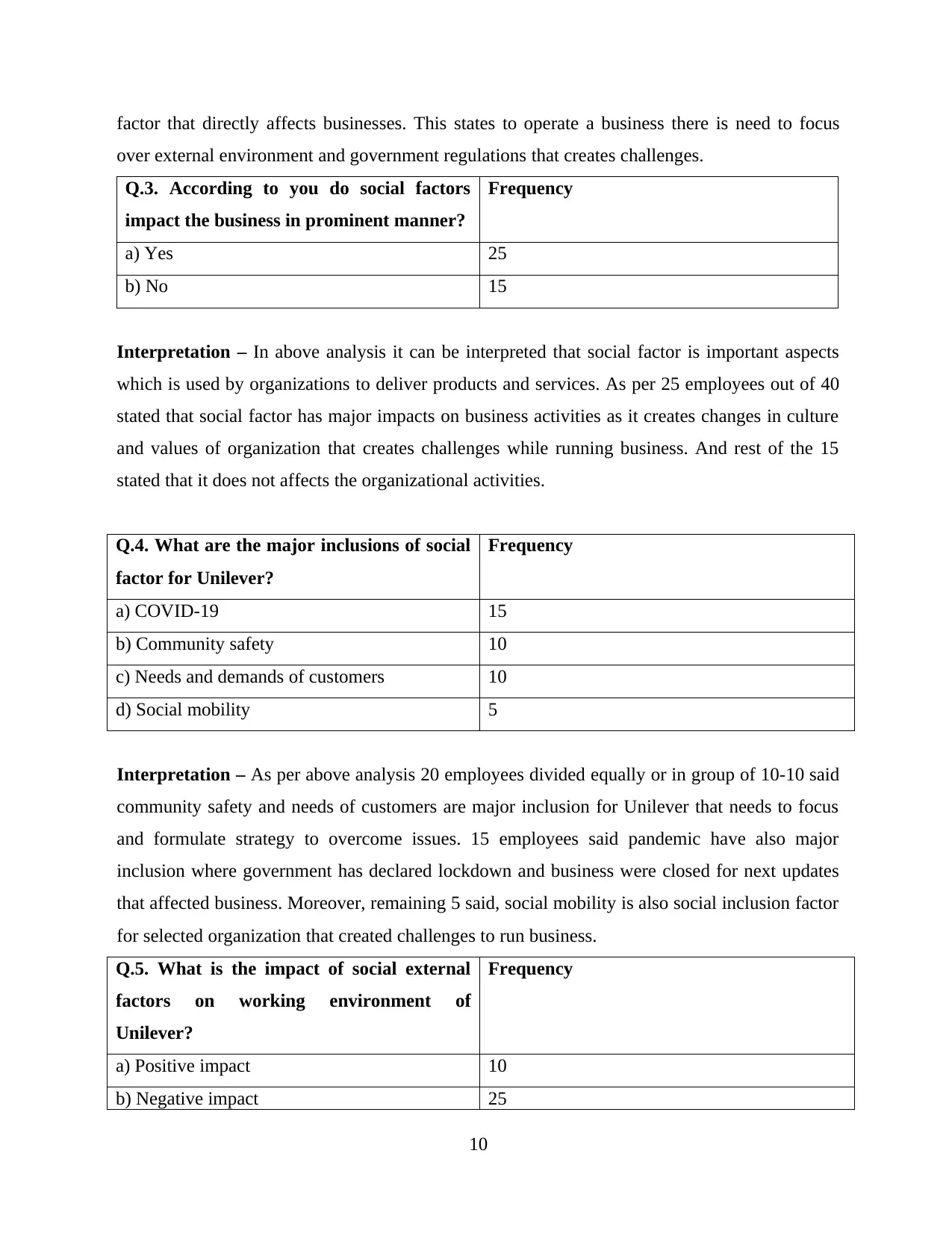
factor that directly affects businesses. This states to operate a business there is need to focus
over external environment and government regulations that creates challenges.
Q.3. According to you do social factors
impact the business in prominent manner?
Frequency
a) Yes 25
b) No 15
Interpretation – In above analysis it can be interpreted that social factor is important aspects
which is used by organizations to deliver products and services. As per 25 employees out of 40
stated that social factor has major impacts on business activities as it creates changes in culture
and values of organization that creates challenges while running business. And rest of the 15
stated that it does not affects the organizational activities.
Q.4. What are the major inclusions of social
factor for Unilever?
Frequency
a) COVID-19 15
b) Community safety 10
c) Needs and demands of customers 10
d) Social mobility 5
Interpretation – As per above analysis 20 employees divided equally or in group of 10-10 said
community safety and needs of customers are major inclusion for Unilever that needs to focus
and formulate strategy to overcome issues. 15 employees said pandemic have also major
inclusion where government has declared lockdown and business were closed for next updates
that affected business. Moreover, remaining 5 said, social mobility is also social inclusion factor
for selected organization that created challenges to run business.
Q.5. What is the impact of social external
factors on working environment of
Unilever?
Frequency
a) Positive impact 10
b) Negative impact 25
10
over external environment and government regulations that creates challenges.
Q.3. According to you do social factors
impact the business in prominent manner?
Frequency
a) Yes 25
b) No 15
Interpretation – In above analysis it can be interpreted that social factor is important aspects
which is used by organizations to deliver products and services. As per 25 employees out of 40
stated that social factor has major impacts on business activities as it creates changes in culture
and values of organization that creates challenges while running business. And rest of the 15
stated that it does not affects the organizational activities.
Q.4. What are the major inclusions of social
factor for Unilever?
Frequency
a) COVID-19 15
b) Community safety 10
c) Needs and demands of customers 10
d) Social mobility 5
Interpretation – As per above analysis 20 employees divided equally or in group of 10-10 said
community safety and needs of customers are major inclusion for Unilever that needs to focus
and formulate strategy to overcome issues. 15 employees said pandemic have also major
inclusion where government has declared lockdown and business were closed for next updates
that affected business. Moreover, remaining 5 said, social mobility is also social inclusion factor
for selected organization that created challenges to run business.
Q.5. What is the impact of social external
factors on working environment of
Unilever?
Frequency
a) Positive impact 10
b) Negative impact 25
10
Paraphrase This Document
Need a fresh take? Get an instant paraphrase of this document with our AI Paraphraser
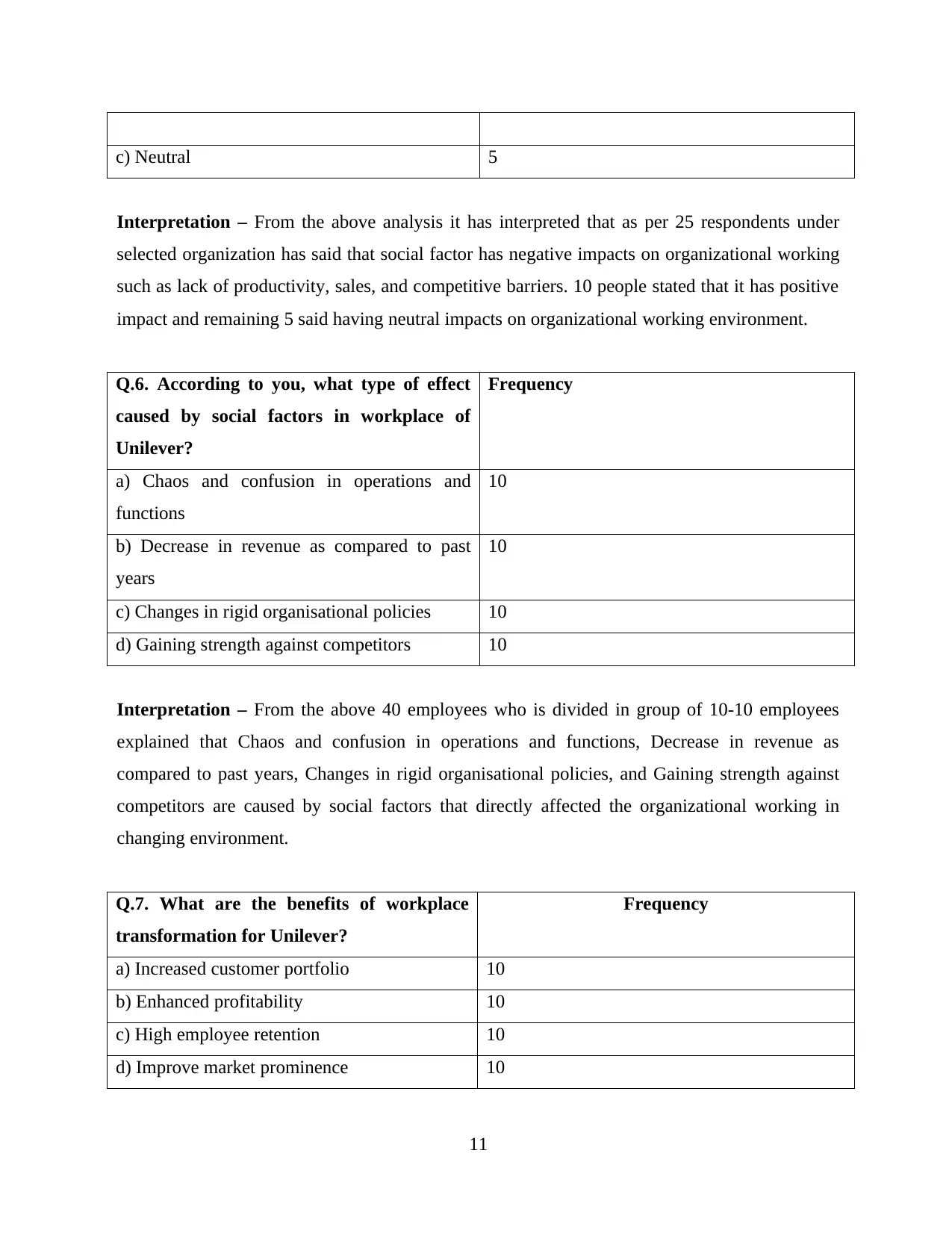
c) Neutral 5
Interpretation – From the above analysis it has interpreted that as per 25 respondents under
selected organization has said that social factor has negative impacts on organizational working
such as lack of productivity, sales, and competitive barriers. 10 people stated that it has positive
impact and remaining 5 said having neutral impacts on organizational working environment.
Q.6. According to you, what type of effect
caused by social factors in workplace of
Unilever?
Frequency
a) Chaos and confusion in operations and
functions
10
b) Decrease in revenue as compared to past
years
10
c) Changes in rigid organisational policies 10
d) Gaining strength against competitors 10
Interpretation – From the above 40 employees who is divided in group of 10-10 employees
explained that Chaos and confusion in operations and functions, Decrease in revenue as
compared to past years, Changes in rigid organisational policies, and Gaining strength against
competitors are caused by social factors that directly affected the organizational working in
changing environment.
Q.7. What are the benefits of workplace
transformation for Unilever?
Frequency
a) Increased customer portfolio 10
b) Enhanced profitability 10
c) High employee retention 10
d) Improve market prominence 10
11
Interpretation – From the above analysis it has interpreted that as per 25 respondents under
selected organization has said that social factor has negative impacts on organizational working
such as lack of productivity, sales, and competitive barriers. 10 people stated that it has positive
impact and remaining 5 said having neutral impacts on organizational working environment.
Q.6. According to you, what type of effect
caused by social factors in workplace of
Unilever?
Frequency
a) Chaos and confusion in operations and
functions
10
b) Decrease in revenue as compared to past
years
10
c) Changes in rigid organisational policies 10
d) Gaining strength against competitors 10
Interpretation – From the above 40 employees who is divided in group of 10-10 employees
explained that Chaos and confusion in operations and functions, Decrease in revenue as
compared to past years, Changes in rigid organisational policies, and Gaining strength against
competitors are caused by social factors that directly affected the organizational working in
changing environment.
Q.7. What are the benefits of workplace
transformation for Unilever?
Frequency
a) Increased customer portfolio 10
b) Enhanced profitability 10
c) High employee retention 10
d) Improve market prominence 10
11
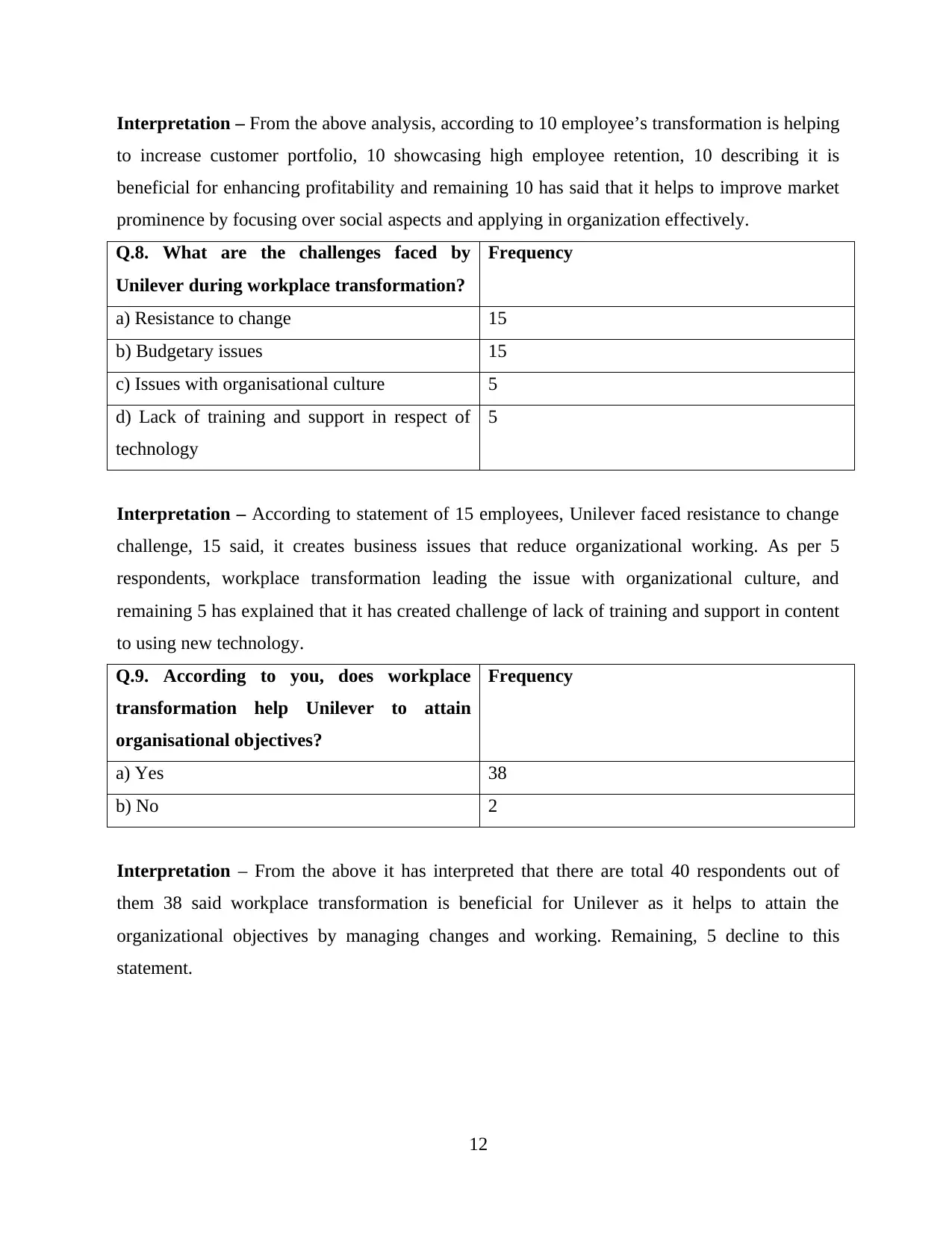
Interpretation – From the above analysis, according to 10 employee’s transformation is helping
to increase customer portfolio, 10 showcasing high employee retention, 10 describing it is
beneficial for enhancing profitability and remaining 10 has said that it helps to improve market
prominence by focusing over social aspects and applying in organization effectively.
Q.8. What are the challenges faced by
Unilever during workplace transformation?
Frequency
a) Resistance to change 15
b) Budgetary issues 15
c) Issues with organisational culture 5
d) Lack of training and support in respect of
technology
5
Interpretation – According to statement of 15 employees, Unilever faced resistance to change
challenge, 15 said, it creates business issues that reduce organizational working. As per 5
respondents, workplace transformation leading the issue with organizational culture, and
remaining 5 has explained that it has created challenge of lack of training and support in content
to using new technology.
Q.9. According to you, does workplace
transformation help Unilever to attain
organisational objectives?
Frequency
a) Yes 38
b) No 2
Interpretation – From the above it has interpreted that there are total 40 respondents out of
them 38 said workplace transformation is beneficial for Unilever as it helps to attain the
organizational objectives by managing changes and working. Remaining, 5 decline to this
statement.
12
to increase customer portfolio, 10 showcasing high employee retention, 10 describing it is
beneficial for enhancing profitability and remaining 10 has said that it helps to improve market
prominence by focusing over social aspects and applying in organization effectively.
Q.8. What are the challenges faced by
Unilever during workplace transformation?
Frequency
a) Resistance to change 15
b) Budgetary issues 15
c) Issues with organisational culture 5
d) Lack of training and support in respect of
technology
5
Interpretation – According to statement of 15 employees, Unilever faced resistance to change
challenge, 15 said, it creates business issues that reduce organizational working. As per 5
respondents, workplace transformation leading the issue with organizational culture, and
remaining 5 has explained that it has created challenge of lack of training and support in content
to using new technology.
Q.9. According to you, does workplace
transformation help Unilever to attain
organisational objectives?
Frequency
a) Yes 38
b) No 2
Interpretation – From the above it has interpreted that there are total 40 respondents out of
them 38 said workplace transformation is beneficial for Unilever as it helps to attain the
organizational objectives by managing changes and working. Remaining, 5 decline to this
statement.
12
⊘ This is a preview!⊘
Do you want full access?
Subscribe today to unlock all pages.

Trusted by 1+ million students worldwide
1 out of 19
Related Documents
Your All-in-One AI-Powered Toolkit for Academic Success.
+13062052269
info@desklib.com
Available 24*7 on WhatsApp / Email
![[object Object]](/_next/static/media/star-bottom.7253800d.svg)
Unlock your academic potential
Copyright © 2020–2025 A2Z Services. All Rights Reserved. Developed and managed by ZUCOL.

